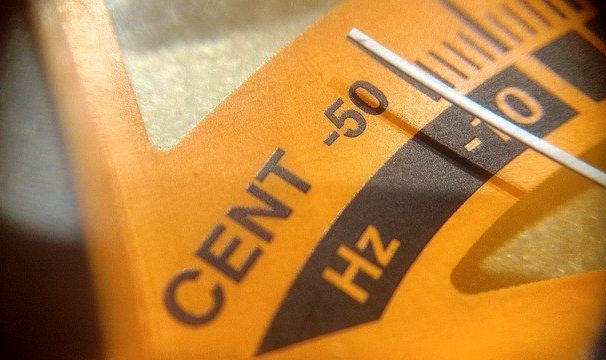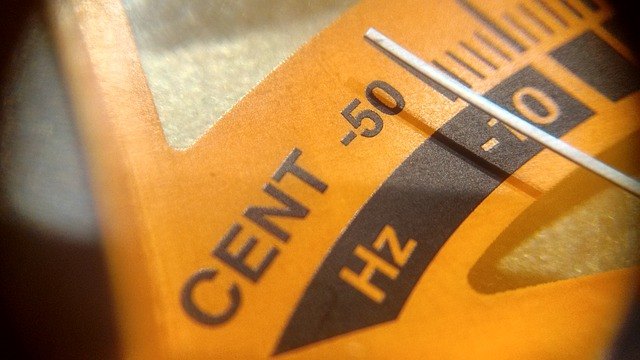
You can find many online guitar tuners. And you might find that most of them work pretty well. So, maybe you’re wondering whether that’s enough. Maybe you don’t need anything but an online guitar tuner. Well, let’s talk about that.
What is a guitar tuner?
A guitar tuner measures the frequency of a tone produced by a vibrating string and compares it to the correct frequency for that string. Typically a needle or some other graphic device indicates when the frequency of the string being tuned matches the target frequency. This enables a guitarist to adjust the length of the guitar string until it produces a tone that matches the reference value on the tuner, which ensures that the string is properly tuned.
A reliable guitar tuner is an indispensable tool for any guitarist. Especially critical to beginner guitarists, it helps those who may not have the necessary experience to judge whether their guitar strings each have the correct pitch.
What is an online guitar tuner?
An online guitar tuner is a software program that typically runs on a web page. It measures the frequency of a tone coming in through the computer’s microphone and compares it to the reference frequency for the string the guitarist is attempting to tune. When the incoming tone matches the reference value, some sort of visual device indicates that the string is in tune.
In other words, an online guitar tuner acts just like any other tuner. Only on a webpage. An online guitar tuner may try to emulate a hardware tuner graphically. It might also attempt to present the information in some new fashion that no hardware unit does or could.
Regardless of the graphic presentation of the online guitar tuner, the basic function remains the same. It strives to help a guitarist tune their instrument easily and accurately.
Why an online guitar tuner can be great
Online guitar tuner software generally costs nothing to use. You need only agree to grant it access to your computer’s microphone so the website can record the tones as you pluck your guitar strings.
It’s easy to find an online guitar tuner. Several options exists and you can find them with a simple search for “online guitar tuner”.
Generally these tuners give pretty accurate results and do a decent job guiding you to the proper tuning of your instrument.
These tuners can also be extremely versatile. While they all offer standard tuning which most of us use most often, many also enable you to tune to alternate tunings. It’s typically very easy to switch to an alternate tuning with a selection from a menu or a button. Once you’ve switched the online guitar tuner to an alternate tuning, the procedure works exactly the same as it does in standard tuning.
How an online guitar tuner falls short
The most obvious problem with an online guitar tuner is that you need to be at your computer in order to use it. Given that you’ll often want to play your instrument when you’re nowhere near your computer, that’s a major obstacle.
Beyond that, online guitar turners come with all of the problems inherent in any web page. You could be subjected to a barrage of annoying advertising. Be careful; these ads often disguise themselves as the very buttons you need to click in order to use the tuner. Click one, and the next thing you know you’re on some website you didn’t want to be at.
Internet connections can fail. Websites can go down right when you need them the most.
Since you need to grant the online guitar tuner access to your computer’s microphone, you create a potential security hole. In the extreme case, you could pick up a damaging computer virus while you think you’re innocently tuning up.
And finally, the quality of the results you get could be questionable. You’re at the mercy of the software programmer that created the tuner. While most of them are likely competent, you never know about free web tools. They could be great, or they could be terrible.
What other options do I have for a guitar tuner?
Of course, the web didn’t invent guitar tuners. The online guitar tuner came about just like so many other things on the web. They try to emulate some sort of hardware device.
And as you might expect, many options for hardware guitar tuners exist. And they have for many years. So hardware tuning technology has become mature and can generally be relied upon without worry.
Strobe instrument tuners
Introduced in 1936 by the Conn company, the very first instrument tuners, called the Stroboconn, use strobe technology.
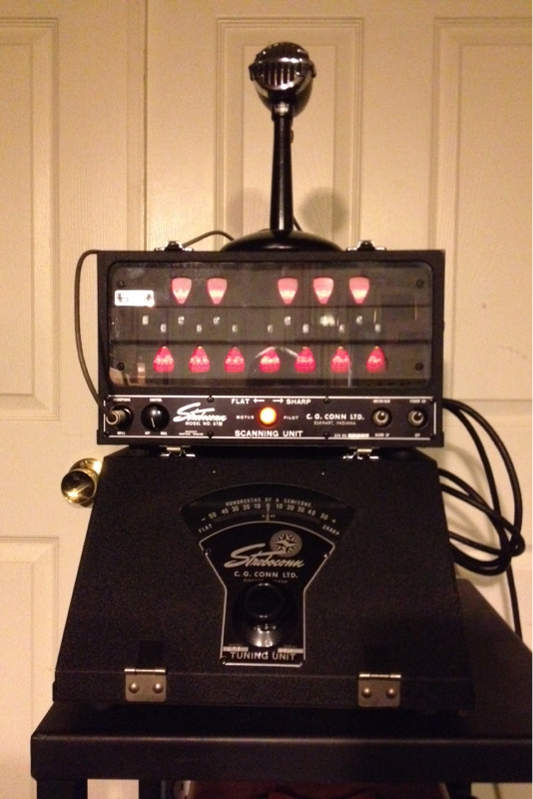
With these tuners, as the tone comes in, it causes a series of light flickers. The frequency of the flickers match the frequency of the incoming tone. These light flickers hit a disk that rotates at a very precise speed. The disk contains markings spaced out according to the reference frequency.
The light flickering on the markings creates a strobe effect. When the marks appear to stop moving, the incoming tone’s frequency matches the reference frequency. The string is in tune.
Strobe tuners provide the most accurate tuning of any type of tuner. Unfortunately, they’re bulky and inconvenient. You won’t be carrying a Stroboconn in your guitar case!
They also contain very delicate parts that need regular maintenance, special care, and accurate calibration.
For these reasons, you’ll usually find strobe tuners in permanent installations within studios and other places that demand the greatest accuracy.
Strobe tuners are still being made today. The rest of the tuners we’ll look at here are not strobe tuners. Rather, they measure tone frequency through electronics.
While these can’t match the accuracy of a strobe tuner, decent ones get very close. “Good enough for rock and roll,” as they say. And they’re portable and reasonably durable, so they make a lot more sense for a guitar player.
Hand-held tuners
These tuners come in generally hand-held size form factors. They often have some sort of clip system that enables you to hang them off of a music stand or something else. Or they sit comfortably on a desk, table, or–if you’re in a real pinch–a steady knee.
They might register the incoming tone with an actual needle, an LCD display, a series of lights, or some other device.
Clip-on tuners
These tuners have become quite popular. They are designed with a clip so you can clip them onto the headstock of your guitar.
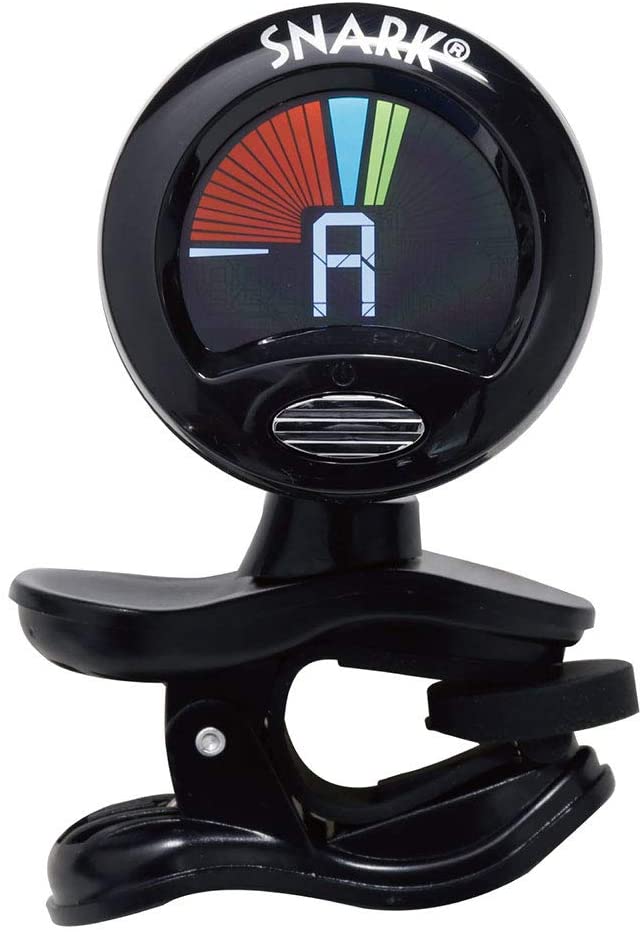
Usually you can set these to use a built-in microphone or vibrations in the wood of your guitar. They’re light and accurate. And you can position them so you can easily see the display when you’re holding your guitar in the playing position.
Many players leave their clip on attached to their guitar through the entire performance so they can easily check their tuning in an instant. I personally don’t like the way that looks, but you have to decide what’s more important: quick access or your rock-star image.
These tuners are generally very affordable. You can get a nice one for somewhere around $15.
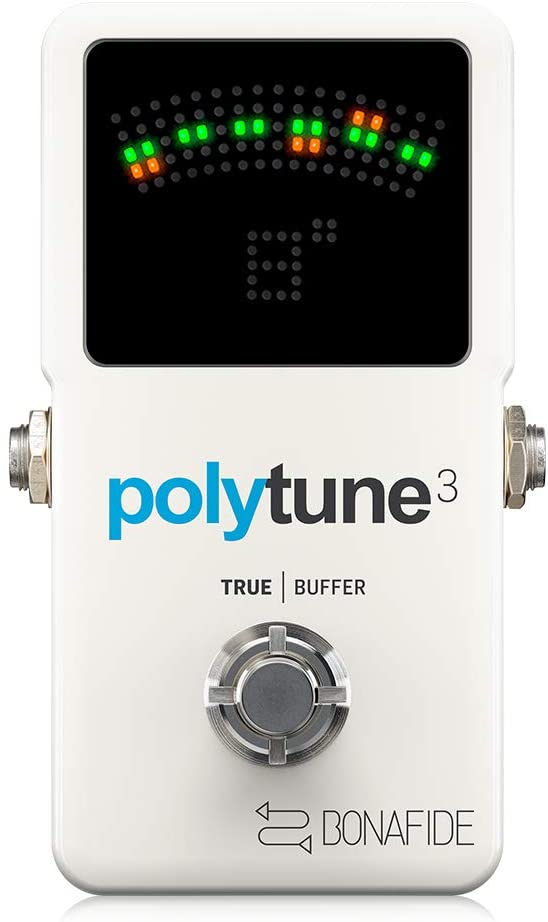
Pedal tuners
Pedal tuners enable the guitarist–typically an electric guitarist–to incorporate their tuner into their effects pedal board. As with other pedals, you plug your guitar or the output of another pedal directly into the tuner. The signal also passes through the tuner so that it can continue on its way to your amplifier or other pedals in your setup.
These pedals are tough in order to withstand the player stomping on them when they need to. They also have more prominent displays so they can easily be seen by a standing guitarist in a dark room or a bright stage.
Mobile guitar tuner apps
Guitar tuner apps are the most similar to an online guitar tuner of all the options. These software applications run on your mobile device.
As with an online guitar tuner, you take the good with the bad. These might not offer the accuracy of electronic tuners. And they might be poorly designed and programmed.
On the other hand, good ones definitely exist and you can download many of them to your device for free. The best thing about these apps, in my opinion? You nearly always have a guitar tuner in your pocket. After all, who goes anywhere without a mobile phone these days?
For that reason, my mobile app is the tuner that I use most often. I always have it. It’s not the one you want to turn to in a performance situation, but it’ll get you by most of the time.
Your trusty ears
Finally, we have to talk about the best guitar tuner of all: your ears. You really must learn to tune your guitar “by ear.” At first, it’s not easy and you’ll likely lack the confidence to do it. But it’s a great first step toward training your ear to hear pitches and tones.
The best thing about this method is that–even more so than a mobile app–if you can hear, you always have your tuner available.
Need to know more about tuning your guitar by ear?
The one downside is accuracy. First, you need an accurate reference tone for at least one of the strings so you can get that into proper tune. Once you have one accurately tuned string, you can tune the others from that one.
But even with a proper reference tone, you may not have trained your ear well enough to tune your instrument accurately. Keep trying! Keep working at it. The ability to hear tones accurately is a very, very useful skill as you strive to figure out songs by ear.
Conclusion
An online guitar tuner can provide a valuable aid for you when you need to tune your guitar. But these software programs running on a website come with some downsides such as portability, potential inaccuracy, and all of the bad things that can come from connecting your computer to the internet.
Strobe tuners provide the greatest accuracy for tuning your instrument, but they are bulky and delicate, so they don’t make much sense for the guitarist.
Instead, various types of electronic tuners work quite well in the practice room or on stage. Handheld, clip-on, and pedal tuners all work with good accuracy.
Finally, the best tuner goes with you wherever you are. Your ears, once you train them properly, ensure that you always have a quality tuner ready for action.
